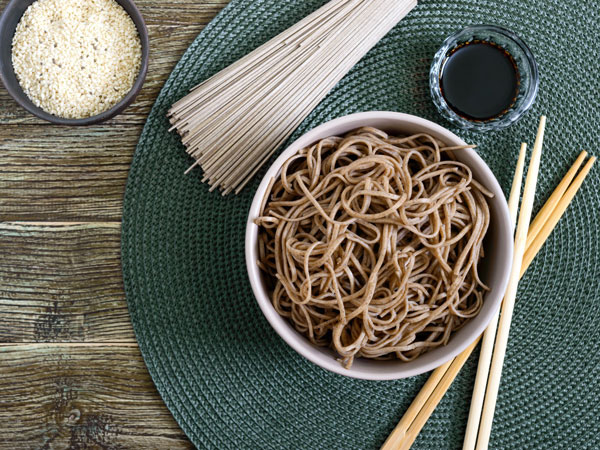Rice noodles are noodles formed from rice flour. Made with rice and water, they sometimes have tapioca, corn starch, or even wheat added to improve their texture. Common across south, east, and south-east Asia, they are mostly bought dried although fresh are available.
Consumption of noodles can be traced back to ancient China. As the story goes, invaders from the north were forced to adapt their wheat based ways to life in the south. Which is rice growing territory. Rice noodles officially became a thing and popularity spread, particularly to the countries of south-east Asia such as Thailand, Vietnam and Malaysia. There they became an essential part of the culture.
Types of rice noodles
Rice noodles come in a huge variety of sizes, and different brands may have just slight variations in their composition. They all have a neutral taste with a gelatinous slightly chewy texture that is perfect as a carrier for other flavours. They tend to be white and slightly see through.
Rice vermicelli are the very fine strands that look like angel hair pasta and are usually packaged as nests or bunches. When cooked they are soft, slippery and slightly chewy. Ideal for broth, or as a spring roll filling.
Thicker and wider noodles are slippery and a little more chewy. More robust, they hold sauce well and absorb bold flavours for the perfect silky noodle dish.
The most popular rice noodles throughout Asia are straight flat noodles known as rice sticks. They come dried and look like packets of linguini. When cooked they are soft and slippery with a moderately firm chewy texture. Also known as pho noodles, or pad thai noodles, they are great for stir fries as they hold together well. Rice stick noodles are not to be confused with ramen noodles, which are made from wheat. Brown rice stick noodles are also available.
Are rice noodles gluten free?
Rice, in itself, is a gluten free grain. Rice noodles do often have other ingredients such as wheat added so it is always best to check the label to be certain.
Are rice noodles healthy?
Rice noodles, when they do not contain any additional wheat, are perfect for a gluten free diet. As with any ingredient, noodles are only as healthy as the rest of the ingredients in your dish. Rice noodles are an excellent source of manganese (for blood sugar regulation), antioxidant selenium, and phosphorus (for helping kidneys filter waste). Brown rice noodles have slightly more nutrient value from fibre and help to lower the net carb value.
How to cook rice noodles
All rice noodles are prepared by soaking in water to soften them. Boiling is too harsh for the delicate structure and will result in soggy claggy noodles. And nobody wants that. Use room temperature water and gently pull them apart with your fingers as they soften. Always follow the instructions on the packet but as a rough guide vermicelli noodles need about 3 minutes, whilst stick noodles need about 10 minutes. Drain well after soaking and toss in a little oil to prevent sticking.
If you want to add rice noodles to hot stock or broth, you do not need to soak them. Drop the noodles into the boiling liquid and serve once soft.
To stir fry rice noodles, add the softened and drained noodles to the pan and stir for a minute before adding sauce.
Thai rice noodles
Rice stick noodles, are perfect for pad thai. Take a shortcut, without compromising on flavour, and use our organic pad thai sauce. Simply stir fry chicken, prawns or tofu with spring onions. Add soaked noodles and then the sauce. Serve with crunchy beansprouts, chopped peanuts and lime wedges.
What to do with leftover rice noodles
If you soak more rice noodles than you need, toss them in a little oil to prevent them from clumping together and keep them in the fridge for up to 3 days. Tossed with a dressing they make a great quick salad, or can be added to soups and stir fries as normal. Tossed with other ingredients they make the ideal filling for a lettuce wrap or spring roll.
Find out more about the ingredients used in Asian cuisine…
Check out our range of organic Asian groceries. Or buy direct from our online Asian grocery store.



